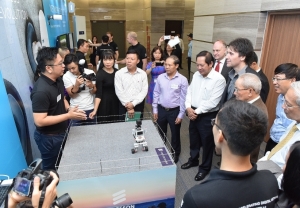Ericsson launches new AI-powered Energy Infrastructure Operations
Integrated into Ericsson Operations Engine – the company’s AI-based, data-driven approach to managed services – the new solution enables service providers to reduce OPEX and CO2 emissions from their networks while maximising site availability.
 |
| The Ericsson Operations Engine offers significant reductions in energy-related OPEX |
Using cutting-edge technology, Energy Infrastructure Operations creates energy efficiencies on the radio network, where most savings can be achieved. The new solution not only addresses site-related energy savings but also operational efficiencies to enable fewer site visits to be performed, ultimately resulting in CO2 emission reduction across multiple layers.
The deployment of AI-powered Energy Infrastructure Operations can achieve a 15 per cent decrease in energy-related OPEX, a 15 per cent reduction in site visits related to passive infrastructure, and a 30 per cent reduction of energy-related outages.
The Energy Infrastructure Operations solution has been trialled with customers in Europe, Asia, the Middle East, and Latin America and is currently live in Telenor Myanmar’s network.
Ruza Sabanovic, CTO of Telenor Group, said, “Telenor Myanmar has worked systematically over the past years to reduce energy consumption and lower carbon emissions. In the last two years, our per-site energy consumption has been reduced by 19 per cent. We've taken another positive step by going live with Ericsson’s energy management solution on the Telenor Myanmar network. This enables us to use machine learning and data analytics to optimise energy use and maximise site availability, helping us to continue working towards our climate ambitions.”
Peter Laurin, SVP and head of Business Area Managed Services, Ericsson, said, “We see a strong focus from our customers on reducing energy consumption as they look to make their operations more efficient and improve their carbon footprint. Our Energy Infrastructure Operations offering is an innovative solution with different efficiency scenarios to address different needs. Its AI-based data-driven approach will enable service providers to achieve OPEX and CAPEX savings as well as reductions in CO2 emissions.”
Today, energy consumption ranges from 20 to 40 per cent of a site operation OPEX annually. According to Ericsson’s AI report, OPEX reduction ranks among the top priorities for operators.
 | Global 5G subscriptions to top 2.6 billion by end-2025: Ericsson report The global number of 5G subscriptions is forecast to top 2.6 billion within the next six years, driven by sustained momentum and a rapidly developing ... |
 | 5G is here and is set to grow faster than any other ‘G’ Digital transformation is an inevitable trend in developing and developed countries alike. 5G networks are going live in many markets and it promises to deliver ... |
 | Ericsson drives Industry 4.0 in Vietnam As a world technology giant, Sweden’s Ericsson has been supporting Vietnam’s vision of leveraging science, technology, and innovation to drive the next wave of hi-tech ... |
What the stars mean:
★ Poor ★ ★ Promising ★★★ Good ★★★★ Very good ★★★★★ Exceptional
Related Contents
Latest News
More News
- Long Thanh International Airport welcomes first Vietnam Airlines test flight (December 15, 2025 | 18:01)
- Health Innovation Hub: accelerating health equity through digital healthcare innovation (December 15, 2025 | 08:00)
- Vietnam’s first AI Law to take effect from March 2026 (December 12, 2025 | 09:00)
- Chi Communications joins SEA CAN alliance (December 11, 2025 | 17:39)
- New Law on High Technology sets incentives and safeguards (December 11, 2025 | 09:00)
- IBTE 2025 to return to Ho Chi Minh City this December (December 11, 2025 | 09:00)
- Masan posts steady gains as Vietnam targets stronger retail growth (December 10, 2025 | 18:58)
- Seafood exports to Japan surge towards new annual record (December 10, 2025 | 18:50)
- Piaggio Vietnam celebrates milestone of two million vehicles produced at Phu Tho factory (December 09, 2025 | 12:11)
- AgriS and Loc Troi partner to boost Vietnam’s rice value chain (December 09, 2025 | 09:00)

 Tag:
Tag:
























 Mobile Version
Mobile Version